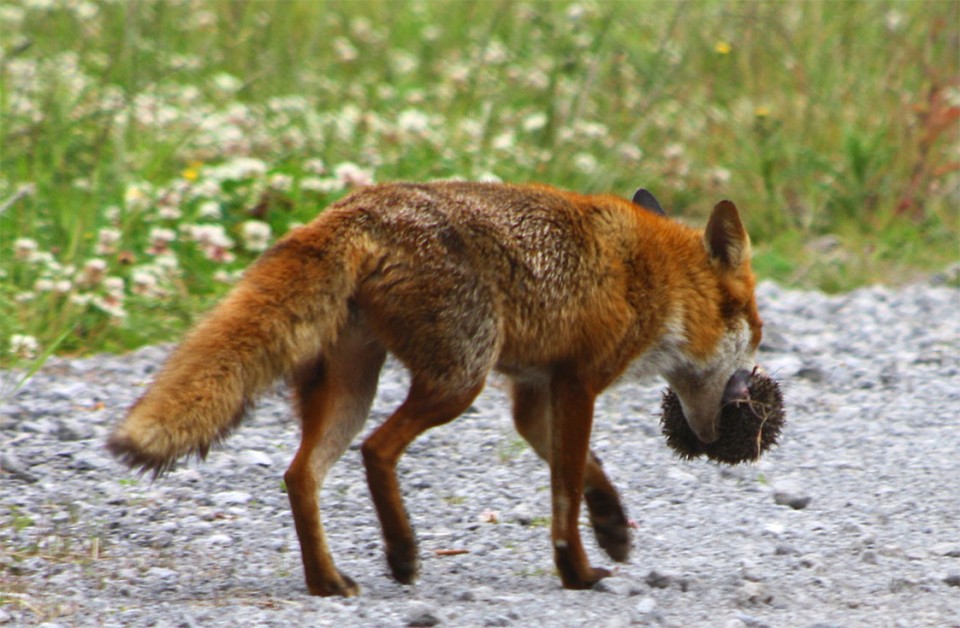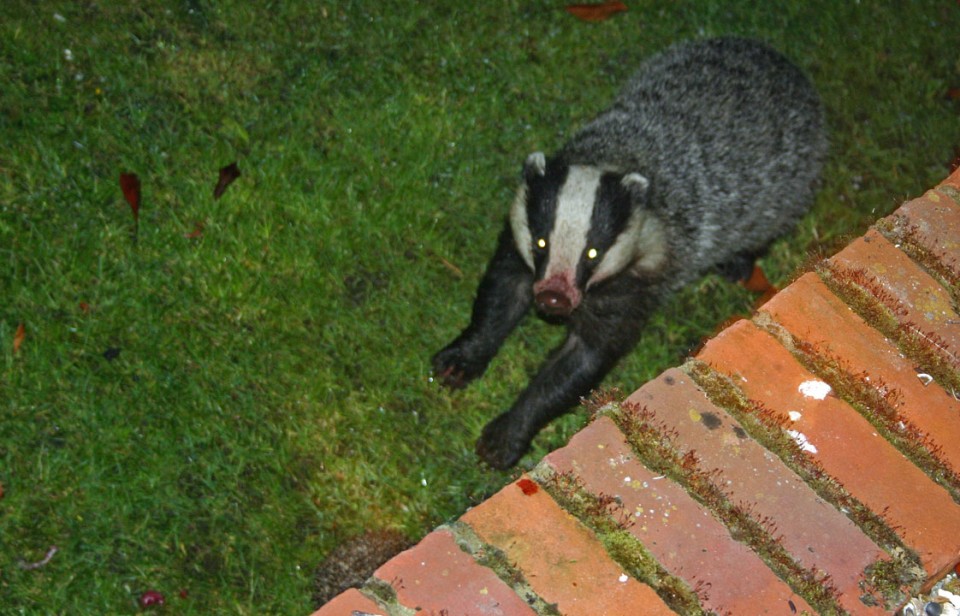European Hedgehog Mortality - Predators
The spines of a hedgehog provide a formidable barrier to most would-be predators and it has been suggested that they probably make hogs less vulnerable to predation than any other mammal of similar size. Despite this, they can still fall prey to other animals. Red foxes (Vulpes vulpes) are widely reputed to catch and kill hedgehogs, although it is not known how common this behaviour is (see QA). Recently there has been concern that hedgehogs may suffer limb amputations from encounters with foxes and, in an article submitted to British Wildlife, David Element wrote:
"... the back legs of adult hedgehogs are also not infrequently amputated by fox-bites although it is sometimes the case that serious incapacitating leg injuries (but not amputations) may be a consequence of fights between adult males as they will try to bite the vulnerable underparts rather than the spiny areas ..."

Other species known to opportunistically take various life-stages of hedgehogs include wild boar (Sus scrofa), otters (Lutra lutra) and various species of small mustelid, including pine martens (Martes martes), weasels (M. nivalis), mink (M. vison), stoats (M. erminea) and polecats (Mustela putorius). Indeed, in his book The Hedgehog, Maurice Burton described the polecat as the hedgehog's "most deadly enemy, by common consent"; apparently they leave nothing, eating flesh, bones, bristles and spines. Brown rats (Rattus norvegicus) may also represent a significant threat, particularly to hibernating individuals. I have received reports from two hedgehog rehabbers describing several cases where hedgehogs have been brought into their care suffering from injuries inflicted by rats, although in only one case was the encounter witnessed. Likewise, in April 2022 a carer in Sheffield reported finding one of two blind hedgehogs that had been hibernating in her secure garden had been killed by what she believed to be a rat, describing the fresh carcass as having had both eyes and much of the nose removed. Indeed, a consistency in the reports I have seen is that rats appear to target the head/face; they will also chew off spines of a rolled-up hedgehog.
Burton also suggests that magpies (Pica pica) may be a significant predator, pulling out a spine and pecking at the wound, and I have received reports from hedgehog carers having treated hedgehogs for injuries sustained during magpie attacks, particularly around the face. Similarly, in his chapter on hedgehogs in the 1981 RSPCA Book of Mammals, Nigel Reeve notes that large birds such as crows can "get past the spines with their beaks and they take some hedgehogs in the early morning". Tawny owls (Strix aluco) are known to take hedgehogs if the opportunity arises and, in June 2020, I saw a report of a gull flying off carrying a small hedgehog in its beak in Scotland, although it's unknown whether this was taken as roadkill. In New Zealand, weak birds (Gallirallus australis) are known to predate hedgehogs.
In parts of Europe, particularly Sweden, eagle owls (Bubo bubo) and can be significant hedgehog predators. Vincenzo Penteriani and his colleagues found that eagle owls living in urban areas of southern France ate more hedgehogs than those on the borders, particularly following an outbreak of myxomatosis that decimated the rabbit population. Luigi Marchesi at the Trento Natural History Museum in Italy and colleagues observed that eagle owls in the Italian Alps took hedgehogs frequently, accounting for about 12% of the total prey and 17% of the mammals eaten; hedgehogs accounted for 25% by mass of the mammals taken, suggesting they were an important component of the diet.
Golden eagles (Aquila chrysaetos) also appear to take hedgehogs and, working in Estonia, Mait Zastrov found hedgehogs were common prey, in a paper to the journal Holarctic Ecology in 1981, Martin Tjernberg reported that he recovered the remains of 24 hedgehogs from eagle territories on the island of Gotland in Sweden; they accounted for about 30% of the total prey taken, and about half of mammal remains. Tjernberg does, however, suggest that most were probably picked up as roadkill, rather than actively predated. In an interview with David Sexton, RSPB officer for Mull, for her book Beak, Tooth and Claw, Mary Colwell recounts "the occasional hedgehog" found during white-tailed (sea) eagle (Haliaeetus albicilla) nest surveys, although much like the golden eagle these may be taken primarily as carrion. Finally, for the avian predators, Red kites (Milvus milvus) feed on hedgehogs and during their study of kite pellets collected in Wales between 1975 and 1978, the late ornithologist Peter Davies found hedgehog remains in three percent and list hedgehogs as "common" in the diet of kites, although this is presumably largely (entirely?) roadkill. Black kites (Milvus migrans) may also take hedgehogs and, apparently referring to kite predation, in his 1962 opus on the mammals of eastern Europe Sergej Ognev wrote:
"In the summer of 1915 I was able to observe the remains of the spiny armor [sic] of not less than 8-9 hedgehogs, among them many old individuals, in the Sychevka County in the park of the Vasilevskoe Estate."

Even combined, the above species contribute relatively little to the problems faced by hedgehogs when compared with the European badger (Meles meles). Badgers appear to be significant predators of hedgehogs and their presence has been implicated in regional (even national) population declines. Indeed, there is some suggestion that badgers may actually represent a barrier to local hedgehog migration (see QA). The point must be made, however, that this is not universally applicable and simply having badgers does not preclude having hedgehogs. Much depends on habitat structure and food availability. In a paper on the hedgehog in London, published in The London Naturalist during 1966, the eminent mammologist Pat Morris wrote:
"... for many weeks Hedgehogs and Badgers used to visit my garden to take food put out for them, and on one occasion both species were photographed together."
People often seem concerned about the impact of domestic cats on hedgehog populations, but I know of no confirmed cases where a cat has attacked a hedgehog, and there is no evidence to suggest they pose a significant threat. The experience of myself and many others is that cats are at best curious of, generally indifferent to, hedgehogs, and I have never observed an aggressive encounter between the two. The video above, taken on the trailcam in my garden, shows a hedgehog displacing the cat from the food plate. Dogs, by contrast, can be a danger to hedgehogs and every year rescue centres treat hogs following encounters with overzealous hounds. In most cases, the dog was not being directly aggressive towards the hedgehog; but even an over-enthusiastic 'mouthing' can cause damage.
How important predators, with the apparent exception of badgers, are as a source of mortality for the hedgehog population in Britain is unknown. Several wildlife rescuers have suggested that "natural causes" pale in comparison to the anthropogenic ones; that more hedgehogs die from contact with cars, strimmers and molluscicides (slug pellets) than from predation. This subject is discussed in more depth in the Interactions with Humans section and QAs.